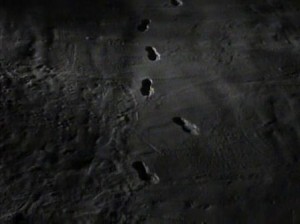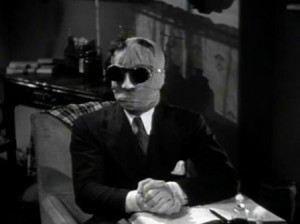The police disguise Kemp but a man who has mastered invisibility isn’t that easily outwitted and Griffin ties his so-called “partner” to the front seat of his car and sends the car over a cliff, but not before detailing the sensations Kemp will experience: “ . . .you’ll have a big thrill for a hundred yards or so until you hit a boulder. Then you’ll do a somersault and probably break your arms. Then a grand finish with a broken neck.”
 In the climax, Griffin removes his clothes to escape the police and takes refuge in a barn—a little unrealistic, considering it’s winter. Having seen a pile of hay move inexplicably, the farmer alerts the police, who surround the house. Griffin tries to escape through the snow but is shot. In one of the film’s numerous technical and factual mistakes, the tracks in the snow are those of a man wearing shoes, though Griffin, remember, is naked!
In the climax, Griffin removes his clothes to escape the police and takes refuge in a barn—a little unrealistic, considering it’s winter. Having seen a pile of hay move inexplicably, the farmer alerts the police, who surround the house. Griffin tries to escape through the snow but is shot. In one of the film’s numerous technical and factual mistakes, the tracks in the snow are those of a man wearing shoes, though Griffin, remember, is naked!
In his deathbed moments, Griffin admits he had dabbled in a forbidden science, and it is only after he has died that visibility returns, and Claude Rains is seen for the first time in the movie.
Besides the cast of familiar faces already listed, there are still more, including small—and they are small—roles for John Carradine, Mary Gordon, Holmes Herbert, Dudley Digges, Robert Adair and Walter Brennan. Cast as a fifteen-year-old newsboy, John Merivale would become the last lover and caretaker of Vivien Leigh after her divorce from Laurence Olivier. And there he is again, another Whale favorite, Dwight Frye, now in a non-horrific role as a reporter.
Rather sophisticated for its time, though many scenes were played for laughs, The Invisible Man is enhanced by a nimble script by R. C. Sherriff, who, being British, added flavor to many British films, including The Four Feathers, Goodbye, Mr. Chips (1939), That Hamilton Woman, Odd Man Out, Mrs. Miniver, and The Dam Busters.
Cinematography was by one of the greats, Arthur Edeson. He had photographed All Quiet on the Western Front, Mutiny on the Bounty (1935), The Maltese Falcon, Casablanca and remember Whale’s “quartet of horror films,” Frankenstein, The Old Dark House, The Invisible Man and The Bride of Frankenstein?—Edeson was behind the camera on all but the last.
The music by Heinz Roemheld is negligible—in quantity and quality, when it’s heard. For a composer who produced so many film scores—mostly for B movies and many with little more than main/end title music—most people would find it challenging to name one of his titles. There are the occasional first-class movies, but they’re not first-class because of his music: The Strawberry Blonde, Gentleman Jim and The Lady from Shanghai.
 As for a film biography of James Whale, Gods and Monsters (1998) gives a fine feeling for the era of the 1950s and Whale’s last years, if not an entirely accurate portrait. It stars Ian McKellen as the director and Brendan Fraser as the young yard man who captures his eye, homosexuality being another of the director’s “distresses.” Whale committed suicide in 1957. In his note, he said that all he had to look forward to was old age and illness.
As for a film biography of James Whale, Gods and Monsters (1998) gives a fine feeling for the era of the 1950s and Whale’s last years, if not an entirely accurate portrait. It stars Ian McKellen as the director and Brendan Fraser as the young yard man who captures his eye, homosexuality being another of the director’s “distresses.” Whale committed suicide in 1957. In his note, he said that all he had to look forward to was old age and illness.
Not too positive a close, but as for The Invisible Man?— All in all, is an enjoyable treat, one of the horror classics. Not to be missed.